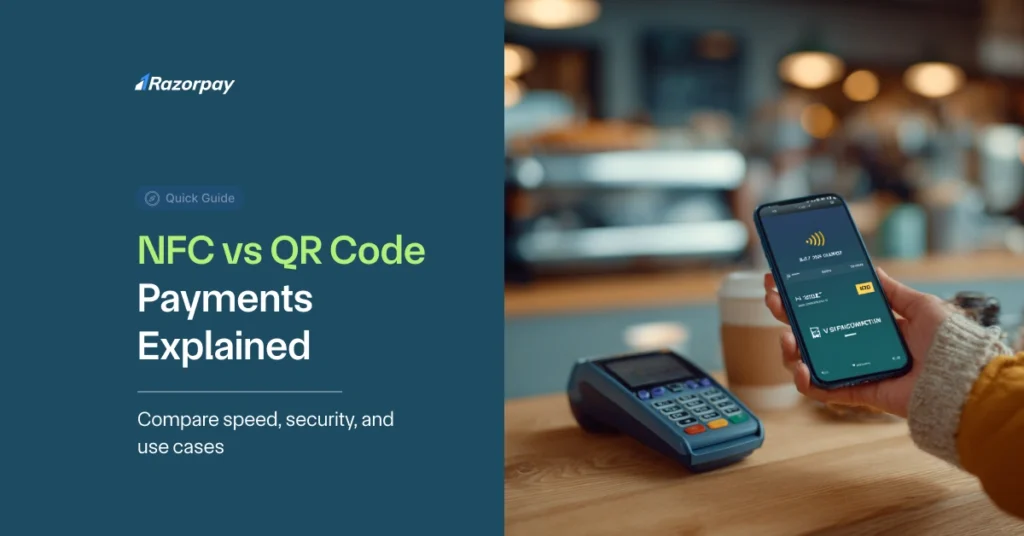Technologies like NFC and QR Codes existed long before they became a medium of transaction. The evolution and widespread acceptance of digital payments gave birth to the concept of contactless transactions based on NFC and QR code. Both are fast, secure and convenient to use. Today, NFC and QR code-based payments have transformed the world of digital commerce. Both technologies require customers to be proximate to merchants, however, both are used in different scenarios. This article will shed light on NFC Vs. QR code, their use cases, and how Razorpay has adapted these technologies into their payment ecosystem for scalability and ease of use.
Before we study their use cases, it is important to understand how NFC and QR codes work.
Key Takeaways
NFC and QR Codes are the two technologies that enable wireless transactions all over the world.
While both technologies allow users to transact quickly and safely. Like any other technology, each have their pros and cons.
Razorpay supports both in an effort to offer a seamless trading experience for both merchants and consumers.
In NFC Vs. QR Code, NFC is a clear winner when it comes to high-value transactions and QR Code wins when it comes to enabling smaller, more localized transactions.
What Are NFC Payments? How Do They Work?
Near-Field Communication technology allows two devices in close proximity to communicate with each other effectively and share data securely. What makes it unique is that the technology is programmed to share data only when two NFC-enabled devices are literally placed adjacent to each other. In payments, customers use their NFC-enabled smartphones, smartwatches or credit cards to tap and pay on PoS terminals at merchant outlets.
Razorpay’s partner-enabled PoS solutions enables merchants to accept wireless cash or card payments.
How Does It Work?
NFC uses the Radio-Frequency Identification (RFID) method to detect and communicate with payment kiosks, enabling secure transactions. When you tap your phone, the POS terminal sends out radio frequency waves which is picked up by nearby payment kiosks/the business’s payment gateway. Upon authentication, the amount is transferred to the merchant’s account, safely and securely within seconds. NFC works with devices that are four inches apart, making it ideal for in-store purchases.
How Is NFC Used For Payments?
Here are a few scenarios where NFC is seen in action.
- Tap and pay POS terminals at merchant outlets.
- Digital Wallets like Google Pay and Apple Pay with the tap-to-pay feature turned on.
There are several benefits to using NFC-enabled sources of payment. A few are listed below:
- Transactions only occur when both NFC-enabled devices touch each other.
- Transactions are secure, as a one-time code with a very short lifespan is generated every time a new one is initiated, making it impossible for imposters to hack into the system and misuse your payment details.
- No internet connection is required.
- NFC-enabled devices include smart watches, digital wallets, NFC chip enabled credit/debit cards, which gives a variety of options to customers.
QR Code Payments
What Is A QR Code?
QR codes are two-dimensional codes that are capable of storing various types of data. Although these were developed in the 1990s, it is only recently that it gained popularity in the financial services domain for contactless payments. In the context of payments, QR codes are commonly used to store transactional data and communicate with POS machines during payment transactions. QR code payments are swift, secure and easy to operate.
QR Codes are mainly of two types, Static and Dynamic. Static QR codes hold permanent information. Transactional data is permanently stored in the code itself and can be accessed multiple times. In dynamic QR codes, one can update/change transactional information, after a code has been generated. The QR code itself doesn’t contain the actual data, but has information about the location where it has been stored. This allows businesses to keep track of the business scans in real time.
How Are QR Codes Used For Payments?
QR codes have gained popularity as a go-to payment mode for businesses and customers alike. Two major reasons behind this shift are – the widespread use of smartphones and the expansion of the internet. Here is how different businesses transact using the QR code payment system.
Retailers: Brick and mortar outlets display static QR codes at their shops to enable customers to use QR code for payment transactions. This step expedites the payment process and is secure and convenient. When customers are ready to pay, they scan these static QR codes by pointing their phone at the displayed code. The merchant’s payment details are then transmitted and displayed on the customer’s screen. Upon validating the same, the customer enters their UPI pin and goes ahead with the transaction.
Restaurants and cafes: Attach a QR code to the final bill and display the image at the reception/billing counter for easy access.
E-Commerce: Online sellers include their QR code in the checkout page, customers can scan these codes to pay their bills.
Key Differences Between NFC and QR Code Payments
NFC and QR codes are both used for contactless payments, however, both have their merits and demerits, depending on the usage. The below table highlights some of the key differences between both technologies.
| Feature | NFC (Tap-to-Pay) | QR Code Payments |
| Range | Few centimeters; requires close proximity | Can be scanned from short distances |
| Device Compatibility | Requires NFC-enabled devices. | Works with any smartphone with a camera |
| Speed | Instant payment processing | Slightly slower due to scanning and confirmation |
| Security | Highly secure with tokenization and encryption | Secure with dynamic codes; less secure with static codes |
| Cost & Setup | Requires NFC-enabled terminals or devices | Low-cost;
only needs a printed or digital QR code |
| Offline Usage | Limited offline support | Static codes can be scanned offline |
NFC Vs. QR Codes – Which Is Better?
Both NFC and QR Code are two different technologies that enable consumers and businesses to transact wirelessly. Their efficiency solely depends on the circumstances under which they are used. For example, restaurants accept digital wallet payments which can be done through QR Codes, however, for high-value transactions, credit/debit cards with a wireless chip (which is NFC-enabled) come in handy.
Why Choose Razorpay for Contactless Payments?
- Accept all payment modes through a single Razorpay account
- Dynamic and static QR codes for easy collections
- POS solutions compatible with NFC tap payments
- Unified dashboard to track and reconcile transactions
- Instant settlement options to keep cash flow smooth
By adopting Razorpay’s payment ecosystem, merchants can future-proof their businesses and give customers the freedom to pay however they prefer — whether it’s tap, scan, or click.
Razorpay’s payment solutions include both NFC and QR Code-based payments!
Conclusion
Both NFC and QR Codes are an effective way to transact wirelessly. While NFC supports secure transactions only when two NFC-enabled devices are close to each other, QR codes employ either static or dynamic codes. Both offer secure, no-contact transactions. When it comes to cost, QR Code is more cost effective than NFC, as consumers have to buy NFC-enabled devices for wireless, tap-to-pay transactions. Razorpay’s payment gateway offers seamless support for both technologies, making it one of the most sought-after payment solutions providers in India.
FAQs
Which method is more secure—NFC or QR Code?
Both methods use strong encryption. While NFC makes use of device-level tokenization, QR codes are authenticated with PIN and the digital wallet’s security. With Razorpay, transactions are monitored in real-time.
Can customers use QR codes without the internet?
Customers can use QR codes to make payments without an internet connection using specialized offline payment solutions in India, such as RBI’s Offline Payments Framework and mobile wallet innovations like OfflinePay.
Do all phones support NFC payments?
Almost all smartphones in 2025 are enabled with NFC. So, yes, smartphones can be used for NFC payments. However, it is advisable to check the phone’s specifications for NFC support.

